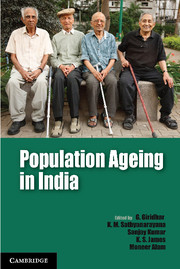Book contents
- Frontmatter
- Contents
- List of Figures
- List of Tables
- Preface
- Acknowledgements
- Introduction
- 1 Demographics of Population Ageing in India
- 2 Elderly Workforce Participation, Wage Differentials and Contribution to Household Income
- 3 Living Arrangements of Elderly in India: Policy and Programmatic Implications
- 4 Health Status of Elderly in India: Trends and Differentials
- 5 The National Policy for Older Persons: Critical Issues in Implementation
- 6 Policy Initiatives on Population Ageing in Select Asian Countries and Their Relevance to the Indian Context
- 7 Studies on Ageing in India: A Review
- Contributors
- Index
5 - The National Policy for Older Persons: Critical Issues in Implementation
Published online by Cambridge University Press: 05 August 2014
- Frontmatter
- Contents
- List of Figures
- List of Tables
- Preface
- Acknowledgements
- Introduction
- 1 Demographics of Population Ageing in India
- 2 Elderly Workforce Participation, Wage Differentials and Contribution to Household Income
- 3 Living Arrangements of Elderly in India: Policy and Programmatic Implications
- 4 Health Status of Elderly in India: Trends and Differentials
- 5 The National Policy for Older Persons: Critical Issues in Implementation
- 6 Policy Initiatives on Population Ageing in Select Asian Countries and Their Relevance to the Indian Context
- 7 Studies on Ageing in India: A Review
- Contributors
- Index
Summary
Overview
The formulation of the National Policy for Older Persons (NPOP) in India in 1999 was in response to the increasing number and proportion of older persons and their disadvantaged status in terms of general social, economic and physical well-being. The demographic transition process has been accompanied by industrialization, urbanization, migration and modernization, resulting in changing values and lifestyles, which contest the traditional values regarding accommodation of the elderly within households.
The special features of the elderly population in India are (1) a majority (80 per cent) of the elderly live in the rural areas, thereby making service delivery a challenge; (2) feminization of the elderly population (51 per cent of the elderly population would be women by the year 2016); (3) increase in the number of the oldest-old (persons above 80 years) and (4) a large proportion (30 per cent) of the elderly live below the poverty line. A combination of these features makes the elderly very vulnerable.
The Constitution of India mandates that the well-being of older persons should be ensured without any discrimination. Many suggestions have been made for designing policies and programmes to ensure equality among the elderly.
- Type
- Chapter
- Information
- Population Ageing in India , pp. 135 - 154Publisher: Cambridge University PressPrint publication year: 2014
- 5
- Cited by

